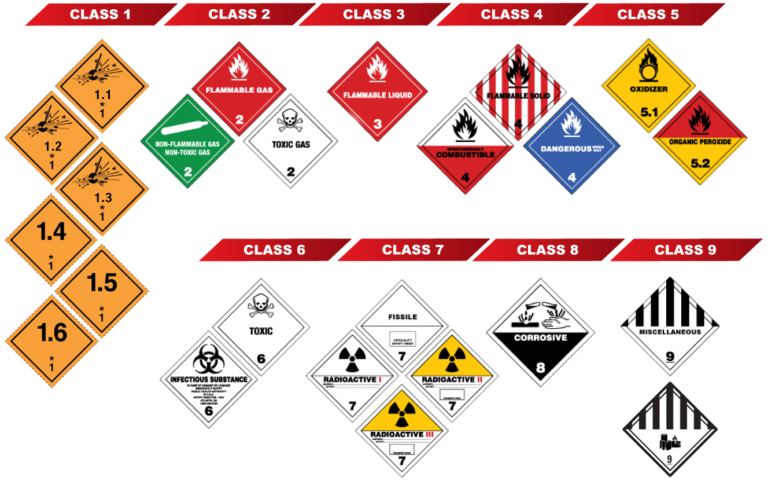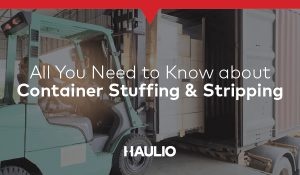Dangerous Goods and their Transportation
What are Dangerous Goods?
Dangerous Goods are articles or substances which are capable of posing a risk to health, safety, property, or the environment when transported. If not handled correctly, Dangerous Goods could harm you, the driver, receiver, other shipments or the environment.
If you’re not sure whether your shipment is dangerous or not, ask the manufacturer or supplier for a Material Safety Data Sheet (MSDS). If it contains a United Nationals (UN) number, it is a dangerous good.
Types of Hazmat Classes
Products that are considered Hazardous Materials, according to the UN Dangerous Goods classification:
- Class 1: Hazardous Materials – Explosives
- Can be identified by an explosive tag.
- “Explosive substance” refer to a solid or liquid substance, or a mixture of solid, liquid or solid and liquid substances, which —
- (a) by chemical reaction, is capable in itself of producing gas at such a temperature, pressure and speed as to cause damage to its surroundings; or
- (b) is designed to produce an effect by heat, light, sound, gas or smoke, or any combination of these, as a result of non-detonative self-sustaining exothermic chemical reaction;
- Examples: Grenades, dynamites and fireworks.
- Class 2: Hazardous Materials – Gases
- Split into 3 divisions.
- Flammable (also called combustible)
- Non-Flammable/Non-Poisonous
- Poisonous
- Examples: Aerosols, insecticide gases
- Split into 3 divisions.
- Class 3: Hazardous Materials – Flammable Liquids
- Any liquid that has an ignition point at or above 37.8°C and below 60.5 °C.
- Examples: Acetone, Gasoline, Paints, Ethanol etc.
- Class 4: Hazardous Materials – Flammable Solids
- Any solid that readily combusts when exposed to a heating agent
- Examples: Activated carbon, sulphur, matches etc.
- Class 5: Hazardous Materials – Oxidizing Agents and Organic Peroxides
- An oxidizer is a chemical that readily yields oxygen in reactions, thereby causing or enhancing combustion.
- Examples: Ferric nitrate, hydrogen peroxide, fertilizer etc.
- Class 6: Hazardous Materials – Toxic and Infectious Substances
- Poisonous material is a material, other than a gas, known to be so toxic to humans that it presents a health hazard during transportation
- Examples: Pesticides, medical/blood trials, motor fuel anti-knock mixtures, and tear gas.
- Class 7: Hazardous Materials – Radioactive Substances
- Radioactive substances are materials that emit radiation.
- Examples: Uranium, radioactive ores, isotopes and some medical equipments or parts.
- Class 8: Hazardous Materials – Corrosive Substances
- A corrosive material is a liquid or solid that causes full thickness destruction of human skin at the site of contact within a specified period of time.
- Examples: Sulfuric acid, strong bases such as sodium hydroxide, batteries and bleach.
- Class 9: Hazardous Materials – Miscellaneous
- The miscellaneous hazardous materials category encompasses all hazardous materials that do not fit one of the definitions listed in Class 1 through Class 8.
- Examples: Magnets, lithium ion batteries, electronic devices, air bag modules and motor engines.

PSA Dangerous Goods Standards
PSA adheres to their own set of standards for dangerous goods:
- PSA Standards: 1, 1D, 1S, 2, 2A, 2B, 2S, 3
Dangerous goods in this classifications are recommended for 24H storage:
- 1S, 2S, 2A, 2B, 2F, 3
Dangerous goods in this classifications are not recommended for storage:
- 1D, 2
To check which classification your goods belong to, click Portnet here.
Transportation of Dangerous Goods
Any vehicle that is used for the transportation of petroleum or flammable materials must be issued with a transport license. This license needs to be shown in the driver’s cabin at all times.
All drivers of hazmat transport vehicles need to have a valid Hazmat Transport Driver Permit (HTDP).
Prior to the approval of the license, the vehicle will also need to undergo a third party inspection to meet the required safety standards.

Lastly, vehicles transporting a net weight of 3 metric tones or more of petroleum or flammable materials or hydrogen, silane & CNG in tubes (regardless of quantity) will need to install a tracking device, immobilizer, horns and blinkers and an orange colour vehicle number plate.
Note: The 3 metric tones refer to 3000 kg or 3000 litres, in the nature physical state of the regulated chemical (i.e. the litres for petroleum and liquid FM; the kg for LPG, gaseous FM and solid FM.
Vehicles installed with tracking devices are to adhere strictly to approved routes and transportation hours. For details, please visit SCDF’s website. Foreign vehicles transporting 3 metric tones or more of petroleum or flammable materials or hydrogen, silane & CNG in tubes (regardless of quantity) will also need to comply with the above requirements, otherwise the vehicle will be turned back at the checkpoint.
How do I get a Hazmat License?
You can apply for this license at the SCDF website or you can apply it on LicenseOne’s website. Click this link to see the steps to register for a license.

Note: Anyone who engages in petroleum storage, dispensing or transportation without a valid license may face a maximum fine of $10,000 and/or imprisonment of 6 months.
What if I am only transporting small amounts of Dangerous Goods?
The transportation of petroleum and flammable materials in the following quantities are exempted from licensing:
Petroleum:
- Less than 130 kg (gross weight) in not more than 2 cylinders;
- Less than 20 litres of Class I petroleum; or
- Less than 200 litres of Class II and Class III petroleum.
Flammable Materials:
- Less than 130 kg (gross weight) in not more than 2 cylinders of flammable gases;
- Less than 20 litres of flammable liquids; or
- Less than 10kg of flammable solids.
Inspection Checklist for Transportation of Dangerous Goods
Transporting dangerous goods? As mentioned previously, you will need to undergo inspections from approved inspection bodies.
Depending on your vehicle type and the amount of dangerous goods, below are inspection checklists you should adhere to.
1) Inspection Checklist For Bulk Transportation - Prime Mover & Trailer, Road Tankers
Transport of petroleum and flammable materials in bulk means transport of petroleum and flammable materials in container more than 250 litres water capacity.
The checklist below applies for:
- Prime movers and trailers (Bulk tank, ISO tank)
- Road tanker (Single entity lorry)
Documents Required:
- Professional Engineer’s certificate
- Manufacturer’s report (new application)
- One copy of tanker drawing endorsed by PE (new application)
- Hydrostatic test report (once every 5 years)
- Radiographic test report (once every 10 years)
- Test certificate issued by LTA (road worthiness)
- Test report (once every 5 years) for ISO tank or BLC
- Transport Emergency Response Plan
- Hazardous Materials Transport Driver Permit
Technical Requirements:
- Exhaust system in order (must be in front)
- Fire shield at rear of cabin provided & in order
- Battery cut off
- Discharge faucets
- Emergency cut off for tanker
- Emergency Information Panel according to Singapore Standard / Code of Practice provided on 3 sides
- Warning sign “Danger, Highly Flammable” according to Petroleum & Flammable Material Regulations displayed at the back of the vehicle bumper (heavy duty steel) 15 cm from tank
- Earthing strap touching the ground
- Metal conduits for all wirings in good condition
- Manhole covers in order
- Coaming satisfactory and projected at least 25 mm above manhole covers
- Pressure , level & temperature gauges provided
- Safety & hydrostatic relief valves provided
- Proper battery compartment
- Vehicle is equipped with one 9 kg dry powder fire extinguisher and
- 1 x 1 kg dry chemical fire extinguisher , or
- 1 x 2.3 kg dry carbon dioxide fire extinguisher
2) Inspection Checklist For Package Transportation - Prime Mover and Trailer
Transport of petroleum and flammable materials in package means transport of any petroleum or any flammable materials in one or more containers of less than 250 litres water capacity.
The checklist below applies for:
- Prime movers and trailers (trucking containers containing petroleum or flammable materials in packages e.g. drums, bottles, pallets etc).
Documents Required:
- Test certificate issued by LTA to prove road worthiness
- Hazardous Materials Transport Driver Permit
- Transport Emergency Response Plan
Technical Requirements:
- Exhaust pipe directed downwards and adequate shrouding (metal cover) to be provided
- Warning sign “Danger, Highly Flammable” according to Petroleum & Flammable Material Regulations displayed at the back of the vehicle
- Fire shield at rear of cabin provided & in order
- Battery cut off
- Earthing strap touching the ground
- Warning labels according Singapore Standard / Code of Practice provided at 3 sides
- Metal conduits for all wirings in good condition
- Proper battery compartment
- Vehicle is equipped with one 9 kg dry powder fire extinguisher and
- 1 x 1 kg dry chemical fire extinguisher , or
- 1 x 2.3 kg dry carbon dioxide fire extinguisher
3) Inspection Checklist For Package Transportation - Vehicles constructed to carry goods
Transport of petroleum and flammable materials in package means transport of any petroleum or any flammable materials in one or more containers of less than 250 litres water capacity.
The checklist below applies for:
- Vehicles constructed to carry goods (e.g. lorries, pick-ups)
Note: Vehicles use for transport of flammable gases must not have a roof covering.
Documents Required:
- Transport Emergency Response Plan
- Test certificate issued by LTA to prove road worthiness
- Hazardous Materials Transport Driver Permit
- Supplier’s authorization letter (for LPG dealers only)
Technical Requirements:
- Platform of the vehicle is lined with timber or is timber constructed so as to minimize contact between the metal parts of the platform and any container
- Protective railings lining the platform of the vehicle are at least 1 m in height in order to secure any container and to prevent such container from falling off the vehicle when the vehicle is in motion
- Glass at the back of the driver cabin, if any is of wired glass or toughened or safety of not less than 6 mm in thickness so as to act as a fire resisting shield
- Battery is covered with appropriate insulation material to prevent electrical spark emanating there form igniting any flammable vapour from any container
- Exhaust pipe is extended at least 150 mm outwards away from the vehicle tail box or is directed downward to keep vehicle exhaust away from any container
- Warning sign “Danger, Highly Flammable” according to Petroleum & Flammable Material Regulations displayed at the back of the vehicle
- Warning labels according Singapore Standard / Code of Practice provided at 3 sides
- Vehicle is equipped with one 9 kg dry powder fire extinguisher and
- 1 x 1 kg dry chemical fire extinguisher , or
- 1 x 2.3 kg dry carbon dioxide fire extinguisher
4) Inspection Checklist For Package Transportation - Vehicles
Transport of petroleum and flammable materials in package means transport of any petroleum or any flammable materials in one or more containers of less than 250 litres water capacity
The checklist below applies for:
- Vehicles such as vans or box-up vehicles.
Documents Required:
- Transport Emergency Response Plan
- Test certificate issued by LTA to prove road worthiness
- Hazardous Materials Transport Driver Permit
Technical Requirements:
- Adequate ventilation on top and bottom (louvers) / exhaust fan
- Battery is covered with appropriate insulation material to prevent electrical spark emanating there form igniting any flammable vapour from any container
- Exhaust pipe is extended at least 150 mm outwards away from the vehicle tail box or is directed downward to keep vehicle exhaust away from any container
- Warning sign “Danger, Highly flammable” according to Singapore Standard / Code of Practice displayed at the back of the vehicle
- Warning labels according Singapore Standard / Code of Practice provided at 3 sides
- Vehicle is equipped with one 9 kg dry powder fire extinguisher and
- 1 x 1 kg dry chemical fire extinguisher , or
- 1 x 2.3 kg dry carbon dioxide fire extinguisher
5) Inspection Checklist For LNG Transportation - Vehicles
The checklist below applies for:
- Vehicles such as prime movers, trailers and road tankers.
Documents Required:
- Manufacturer’s data report (eg. ASME U-Stamp, EN code, etc… )
- A copy of prime mover/trailer/tanker drawing endorsed by PE
- A copy of prime mover/trailer/tanker technical calculations for stability endorsed by PE (New Tank)
- Test certificate issued by LTA to prove road worthiness
- A copy of prime mover/trailer/tanker photos from front, side and rear (including licence plate)
- Hazardous Materials Transport Driver Permit
- Hydrostatic test or any equivalent test report endorse by local PE (New Tank)
- Radiographic test or any equivalent test report endorse by local PE(New Tank)
- Pneumatic or equivalent test report for tank and manifold piping system (working pressure) endorsed by PE (once every 5 years )
Technical Requirements:
- Prime Mover/ Road Tanker equipped with ABS system
- Fire shield at rear of cabin provided and in order
- Roll Over Prevention Stability System provided
- Exhaust system in order (adequately shielded from direct contact with fuel from overfilled tanks and leaks)
- Rear and side under-run protection (heavy duty steel) 15 cm from tank
- Metal conduits for all electrical wirings in good condition
- Anti-Tow Interlocks systems (to prevent driving away while connected to driving rack or during dispensing) in order
- Battery cut off in order / Proper battery compartment
- 2 x 9 kg dry powder and 1 x 1 kg dry powder / 2.5 kg CO2 fire extinguishers
- Transport Emergency Information panel (TEIP) complying with GHS (Warning notices) provided at 3 sides
- Earth winch shall be provided for operating during load and unloading of LNG
- Spark arrestor ( Flame Trap) provided
- Earthing strap provided and touching the ground
- Visual Inspection on Outer Vessel / Tank (eg. to inspect for any sign on sweating, cold spots or algae)
- All vent pipe nozzles are piped upwards and are not piped downwards to the chassis (LNG Trailer/ ISO Tanker)
- Discharge Faucets in order
- Lighting in cabinets shall be Vapor Proof design or explosion proof design (Intrinsically safe)
- Cabinet enclosure shall be designed with louvers
- Wiring circuit shall be house in steel conduits
- All valves and Safety pressure relief valves in working order
- Pressure and Level gauges in working order
- Vacuum reading in working order (< 20 micron)
- Emergency cut off device in working order
- Pump, Vaporizer and piping yearly maintenance report (Renew)
Questions?
We’re happy to help! Fill in the form below and we’ll get back to you shortly.






